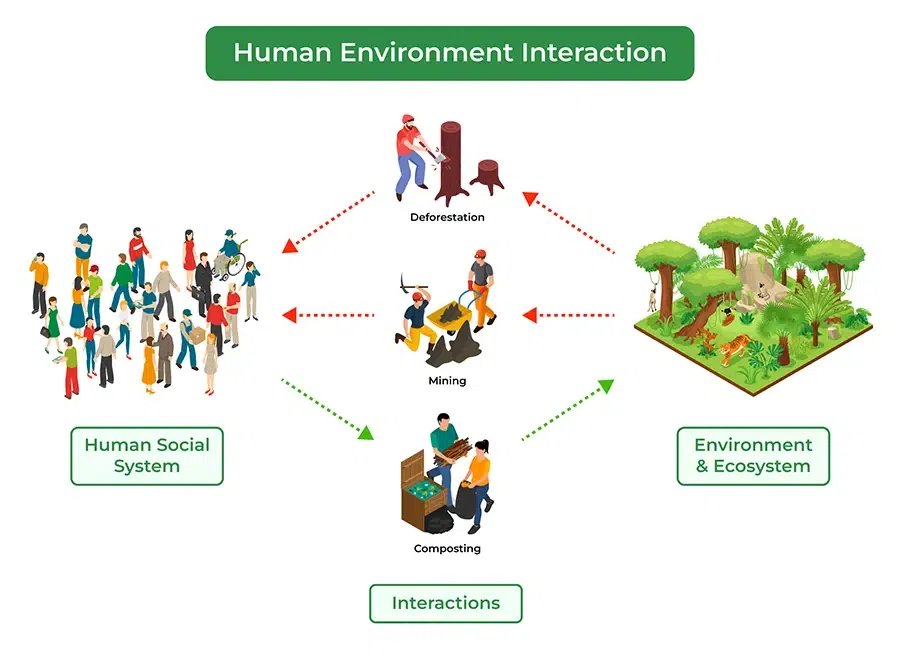Human environment interaction refers to the ways in which people interact with their surroundings. Cities built along rivers, such as London along the Thames, showcase this dynamic relationship. Forest clearing for agriculture and urban sprawl are further examples of human impact on the environment. Industrial activities leading to air and water pollution, like in many urban areas, demonstrate another facet of this interaction. Understanding these examples can shed light on the intricate balance between human activities and the environment.
What Are Some Examples of Human Environment Interaction
Introduction
Human-environment interaction refers to the relationship between humans and their surrounding environments. Throughout history, humans have interacted with the environment in various ways, shaping and being shaped by their surroundings. In this article, we will explore some examples of human environment interaction and how these interactions have influenced both people and the environment.
Agriculture
One of the earliest examples of human environment interaction is agriculture. When humans transitioned from hunter-gatherer societies to farming communities, they fundamentally changed their relationship with the environment. By clearing land, planting crops, and raising animals, humans began to modify the natural landscape to meet their needs.
Agriculture not only transformed the environment by creating fields and pastures but also had a profound impact on human societies. The development of agriculture allowed for the growth of permanent settlements, the rise of complex civilizations, and the specialization of labor.
Impact of Agriculture on the Environment
While agriculture has led to increased food production and the growth of human populations, it has also had negative consequences on the environment. Deforestation, soil erosion, and water pollution are some of the environmental issues that have arisen due to intensive farming practices.
Urbanization
Urbanization is another significant example of human environment interaction. As populations have grown, more and more people have moved to cities in search of economic opportunities and a better quality of life. This mass migration to urban areas has transformed the natural landscape into sprawling cityscapes.
The rise of cities has led to the development of infrastructure such as roads, buildings, and utilities. While urbanization has brought about advancements in technology and increased access to services, it has also placed a strain on the environment. Pollution, habitat destruction, and the loss of green spaces are some of the environmental challenges associated with urbanization.
Sustainable Urban Planning
To mitigate the negative impacts of urbanization on the environment, city planners are increasingly focusing on sustainable urban development. This involves designing cities in a way that minimizes resource consumption, reduces emissions, and promotes biodiversity.
Industrialization
The Industrial Revolution marked a turning point in human history, as it brought about rapid industrialization and urbanization. Factories, powered by steam engines and later electricity, transformed manufacturing processes and increased production on a massive scale.
Industrialization has had a profound impact on the environment through the extraction of natural resources, the release of pollutants, and the alteration of landscapes. The burning of fossil fuels for energy has contributed to climate change, while industrial waste has contaminated air, water, and soil.
Environmental Regulations
In response to the environmental degradation caused by industrialization, governments around the world have implemented regulations to protect the environment. Laws governing emissions, waste disposal, and land use have been put in place to limit the negative impacts of industrial activities.
Transportation
The development of transportation systems, from roads and railways to airplanes and ships, has revolutionized the way humans interact with the environment. Transportation networks have connected people and goods across great distances, facilitating trade, communication, and travel.
The construction of transportation infrastructure, however, has come at a cost to the environment. Deforestation for road building, air pollution from vehicles, and oil spills from ships are some of the environmental consequences of transportation systems.
Green Transportation Initiatives
In recent years, there has been a growing emphasis on green transportation initiatives to reduce the environmental impact of transport. Electric vehicles, public transit systems, and bike-sharing programs are examples of sustainable transportation options that aim to decrease emissions and promote eco-friendly travel.
Waste Management
The way humans dispose of waste is another critical aspect of human environment interaction. As populations have grown and consumption has increased, the amount of waste generated has also risen. Improper waste disposal can lead to pollution, habitat destruction, and health risks for both humans and wildlife.
Efforts to manage waste more sustainably, such as recycling, composting, and waste-to-energy technologies, are essential for reducing the environmental impact of human activities. By minimizing waste and maximizing resource recovery, communities can lessen their ecological footprint and preserve natural resources.
Community Recycling Programs
Community recycling programs play a vital role in waste management by providing residents with options to recycle materials such as paper, glass, plastic, and metal. By participating in recycling initiatives, individuals can help reduce the amount of waste sent to landfills and conserve valuable resources.
Human environment interaction is a complex and multifaceted phenomenon that has shaped the course of human history and influenced the natural world. From agriculture and urbanization to industrialization and transportation, the ways in which humans interact with their environment have both positive and negative consequences.
By understanding the examples of human environment interaction discussed in this article and working towards sustainable practices, we can strive to create a more harmonious relationship between humans and the environment. Through responsible stewardship and proactive measures, we can protect the planet for future generations and ensure a healthy and thriving environment for all.
Human Environment Interaction in Geography – Definition, Examples & Solutions
Frequently Asked Questions
How do humans interact with the environment around them?
Humans interact with the environment in various ways, some examples include altering landscapes through agriculture, building infrastructure like roads and cities, and modifying natural resources for energy production.
What are some examples of human impact on the environment?
Human activities such as deforestation, pollution, overfishing, and urbanization have significant impacts on the environment, leading to habitat destruction, biodiversity loss, and climate change.
How does human behavior influence local ecosystems?
Human behavior can disrupt local ecosystems by introducing invasive species, polluting water sources, and causing habitat fragmentation, which can harm wildlife populations and destabilize natural processes.
What role does human-environment interaction play in shaping cultures and societies?
The relationship between humans and the environment has influenced cultural practices and societal structures throughout history, such as shaping agricultural traditions, influencing settlement patterns, and impacting resource management strategies.
Final Thoughts
In conclusion, human-environment interaction encompasses a wide range of activities where humans impact the natural world and are in turn impacted by it. Examples include deforestation for agricultural purposes, pollution of water bodies through industrial activities, and construction of infrastructure in coastal areas leading to erosion. Understanding what human environment interaction entails is crucial for promoting sustainable practices and ensuring the well-being of both humans and the environment.






